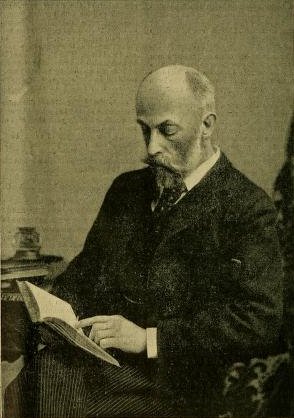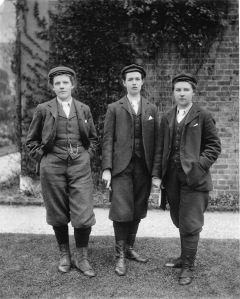|
William Thiselton-Dyer
Sir William Turner Thiselton-Dyer (28 July 1843 – 23 December 1928) was a leading British botanist, and the third director of the Royal Botanic Gardens, Kew. Life and career Thiselton-Dyer was born in Westminster, London. He was a son of William George Thiselton-Dyer (1812-1868), physician and Catherine Jane, née Firminger (1815-1897), botanist. He was educated at King's College School where he was first mathematical scholar, and later proceeded to the medical department of King's College London, where he remained until 1863 when he proceeded to Christ Church, Oxford. Initially studying mathematics at Christ Church, Oxford, he graduated in natural science in 1867. He became Professor of Natural History at the Royal Agricultural College in Cirencester and then Professor of Botany at the Royal College of Science for Ireland in Dublin. In 1872, he became professor at the Royal Horticultural Society in London, being recommended by Joseph Dalton Hooker. Then in 1875, Thiselton ... [...More Info...] [...Related Items...] OR: [Wikipedia] [Google] [Baidu] |
Trinidad
Trinidad is the larger and more populous of the two major islands of Trinidad and Tobago. The island lies off the northeastern coast of Venezuela and sits on the continental shelf of South America. It is often referred to as the southernmost island in the West Indies. With an area of , it is also the List of Caribbean islands by area, fifth largest in the West Indies. Name The original name for the island in the Arawak language, Arawaks' language was which meant "Land of the Hummingbird". Christopher Columbus renamed it ('The Island of the Holy Trinity, Trinity'), fulfilling a vow he had made before setting out on his third voyage. This has since been shortened to ''Trinidad''. History Island Caribs, Caribs and Arawaks lived in Trinidad long before Christopher Columbus encountered the islands on his third voyage on 31 July 1498. The island remained Spanish until 1797, but it was largely settled by French colonists from the French Caribbean, especially Martinique.Besson, ... [...More Info...] [...Related Items...] OR: [Wikipedia] [Google] [Baidu] |
Harriet Anne Hooker Thiselton-Dyer
Lady Harriet Anne Thiselton-Dyer ( Hooker; 1854–1945) was a British botanical illustrator. Life and career Harriet Anne Hooker was born in 1854 to the botanist and explorer Joseph Dalton Hooker and Frances Harriet Henslow, who was the daughter of botanist and Cambridge University professor John Stevens Henslow. In 1877, she married the botanist William Turner Thiselton-Dyer (later knighted), with whom she had a son and a daughter. Thiselton-Dyer belonged to a generation of English women who transformed their interest in botany into professional careers. She studied with the noted botanical illustrator Walter Hood Fitch, who was the lead artist for ''Curtis's Botanical Magazine''. After Fitch resigned from the magazine in 1877 following a dispute with her father—for whom Fitch had been preparing illustrations for several books—Thiselton-Dyer stepped in. She rendered almost 100 illustrations for publication during the period 1878–1880, helping to keep the magazine viable ... [...More Info...] [...Related Items...] OR: [Wikipedia] [Google] [Baidu] |
Henry Trimen
Henry Trimen (26 October 1843 – 16 October 1896) was a British botanist who worked in Sri Lanka. He named several plants in the family Dipterocarpaceae. Life Trimen was born in Park Place, Paddington, London, England, the son of Richard and Marinne Trimen and the younger brother of entomologist Roland Trimen. He graduated from King's College School, London and from King's College Medical School, Edinburgh, but never practiced medicine. Like his brother Roland, he collected all kinds of natural history specimens but later restricted himself to plants. He began medical studied in 1860 and spent some time in 1864 at the University of Edinburgh acting as a clinical assistant to Professor Bennett. He also became a friend of Professor J.H. Balfour at the Edinburgh Botanical Society. Trimen took part in reforms of the Linnean Society in 1872 and included dates of publication at the backs of the ''Journal of Botany'' where he served as editor. He was the curator of the medical muse ... [...More Info...] [...Related Items...] OR: [Wikipedia] [Google] [Baidu] |
Index Kewensis
The 1893 ''Index Kewensis'' (IK), maintained by the Royal Botanic Gardens, Kew, is a publication that aims to register all botanical names for seed plants at the rank of species and genera. It later came to include names of taxonomic families and ranks below that of species. The ''Index'' is currently maintained as part of the International Plant Names Index in combination with the Gray Herbarium and Australian Plant Name indexes. This database is anticipated to complete the task of creating a complete list of plant names, although it does not determine which are accepted species names. History The preparation for this venture was made by Benjamin Daydon Jackson of the Linnaean Society, directed by Joseph Dalton Hooker at Kew. Charles Darwin provided the funding for the indexing project. When he died in 1882 his will stipulated that provision be made for £250 per annum over a 5-year period. In providing citations of plant names, the starting point was taken from 1753 onward ... [...More Info...] [...Related Items...] OR: [Wikipedia] [Google] [Baidu] |
Julius Sachs
Julius Sachs (July 6, 1849 – February 2, 1934) was an American educator, founder of the Sachs Collegiate Institute who belongs to the Goldman–Sachs family of bankers. Sachs was born on July 6, 1849, in Baltimore. After taking his A.B. at Columbia in 1867 and his A.M. in 1871, he studied at several European universities. He was awarded a Ph.D. in 1871 by the University of Rostock. He married Rosa Goldman, daughter of investment banker Marcus Goldman, in 1874. He founded Sachs School for Boys in 1872, and served as the school's principal for 32 years. He also founded the Sachs School for Girls, which he directed for 18 years. After he was appointed Professor of Education at Teachers College, Columbia University, the schools were discontinued. At Sachs Collegiate Institute and Columbia University, Sachs tutored many students who later became distinguished figures in American life, such as Herbert H. Lehman, Irving Lehman, Walter Lippmann, and Hans Zinsser. He retired from ... [...More Info...] [...Related Items...] OR: [Wikipedia] [Google] [Baidu] |
University Of Bristol
, mottoeng = earningpromotes one's innate power (from Horace, ''Ode 4.4'') , established = 1595 – Merchant Venturers School1876 – University College, Bristol1909 – received royal charter , type = Public red brick research university , endowment = £91.3 million (2021) , budget = £752.0 million (2020–21) , chancellor = Paul Nurse , vice_chancellor = Professor Evelyn Welch , head_label = Visitor , head = Rt Hon. Penny Mordaunt MP , academic_staff = 3,385 (2020) , students = () , undergrad = () , postgrad = () , city = Bristol , country = England , coor = , campus = Urban , free_label = Students' Union , free = University of Bristol Union , colours = ... [...More Info...] [...Related Items...] OR: [Wikipedia] [Google] [Baidu] |
Louisiana Purchase Exposition
The Louisiana Purchase Exposition, informally known as the St. Louis World's Fair, was an World's fair, international exposition held in St. Louis, Missouri, United States, from April 30 to December 1, 1904. Local, state, and federal funds totaling $15 million were used to finance the event. More than 60 countries and 43 of the then-45 American states maintained exhibition spaces at the fair, which was attended by nearly 19.7 million people. Historians generally emphasize the prominence of the themes of Race (human categorization), race and imperialism, and the fair's long-lasting impact on intellectuals in the fields of history, art history, architecture and anthropology. From the point of view of the memory of the average person who attended the fair, it primarily promoted entertainment, consumer goods and popular culture. The monumental Greco-Roman architecture of this and other fairs of the era did much to influence permanent new buildings and master plans of major cities. ... [...More Info...] [...Related Items...] OR: [Wikipedia] [Google] [Baidu] |
Exposition Universelle (1900)
The Exposition Universelle of 1900, better known in English as the 1900 Paris Exposition, was a world's fair held in Paris, France, from 14 April to 12 November 1900, to celebrate the achievements of the past century and to accelerate development into the next. It was held at the esplanade of Les Invalides, the Champ de Mars, the Trocadéro and at the banks of the Seine between them, with an additional section in the Bois de Vincennes, and it was visited by more than 50 million people. Many international congresses and other events were held within the framework of the Exposition, including the 1900 Summer Olympics. Many technological innovations were displayed at the Fair, including the ''Grande Roue de Paris'' ferris wheel, the '' Rue de l'Avenir'' moving sidewalk, the first ever regular passenger trolleybus line, escalators, diesel engines, electric cars, dry cell batteries, electric fire engines, talking films, the telegraphone (the first magnetic audio recorder), the ... [...More Info...] [...Related Items...] OR: [Wikipedia] [Google] [Baidu] |
University Of London
The University of London (UoL; abbreviated as Lond or more rarely Londin in post-nominals) is a federal public research university located in London, England, United Kingdom. The university was established by royal charter in 1836 as a degree-awarding examination board for students holding certificates from University College London and King's College London and "other such other Institutions, corporate or unincorporated, as shall be established for the purpose of Education, whether within the Metropolis or elsewhere within our United Kingdom". This fact allows it to be one of three institutions to claim the title of the third-oldest university in England, and moved to a federal structure in 1900. It is now incorporated by its fourth (1863) royal charter and governed by the University of London Act 2018. It was the first university in the United Kingdom to introduce examinations for women in 1869 and, a decade later, the first to admit women to degrees. In 1913, it appointe ... [...More Info...] [...Related Items...] OR: [Wikipedia] [Google] [Baidu] |
Alice Hutchins (gardener)
Alice Hutchins (c. 1870 – 24 January 1944) was one of the two first women gardeners hired at Kew Gardens in 1896. Education Hutchins trained at the Horticultural College for Women at Swanley in Kent after it began accepting women in 1891. Her studies were funded by a Kent County Council Scholarship. She received a College Diploma after the two-year program. Kew Gardens In 1896, she and Annie Gulvin were the first women hired by Director William Thiselton-Dyer at Kew Gardens as "improvers". They received the same salary as male staff. They initially wore the same uniforms as the male garden staff to ensure order and consistency. These bloomers drew media attention and criticism, so they were swapped for skirts. Hutchins worked long hours and performed physical tasks in addition to studying chemistry, botany and horticulture in the evenings. By 1897, she had been promoted to gardener and was responsible for certain houses and frames in the garden. She received top marks ... [...More Info...] [...Related Items...] OR: [Wikipedia] [Google] [Baidu] |







